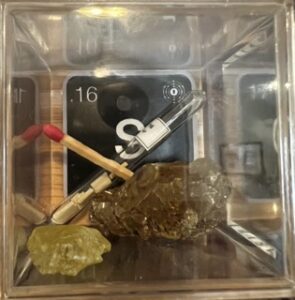Sulfur – Sulphur
Atomic Number: 16
Atomic Mass: 32.065 u

Sulfur, a bright yellow and odorous element, is not just a staple of science class demonstrations but a crucial player in a wide range of modern applications. With its symbol ‘S’ and atomic number 16, sulfur stands out in the periodic table and in real-world applications. Delve into the fascinating world of sulfur, exploring its unique properties and the diverse ways it is used today.
Understanding Sulfur
Sulfur is a nonmetallic element known for its bright yellow crystalline appearance. It is famous for its ‘rotten egg‘ smell, which is actually due to sulfur-containing compounds, rather than elemental sulfur itself. Naturally occurring in volcanic emissions and hot springs, sulfur has been known since ancient times and was once referred to as “brimstone”.
Key Uses of Sulfur in Modern Times
1. Fertilizers
Perhaps the most significant use of sulfur today is in the production of fertilizers. Sulfur is a critical nutrient for plant growth, aiding in chlorophyll production and the synthesis of essential amino acids. The majority of sulfur produced globally is used to create phosphatic fertilizers, providing nourishment to crops worldwide.
2. Industrial Applications
- Chemical Manufacturing: Sulfur is a key ingredient in producing sulfuric acid – one of the most widely used chemicals in industry. Sulfuric acid has a myriad of applications, including in the manufacture of fertilizers, in mineral extraction, and as a cleaning agent in various industries.
- Vulcanization of Rubber: Sulfur is essential in the vulcanization process of rubber, making it more durable and elastic. This process is crucial for producing car tires, hoses, and conveyor belts.
3. Environmental Protection
- Reducing Air Pollution: Sulfur compounds play a significant role in environmental protection. Technologies like flue-gas desulfurization remove sulfur dioxide from power plant emissions, helping to reduce acid rain and air pollution.
- Battery Technology: Sulfur is being explored for use in advanced battery technologies, such as lithium-sulfur batteries, which promise higher energy density and lower environmental impact compared to traditional lithium-ion batteries.
4. Pharmaceuticals and Cosmetics
- Medicinal Uses: Historically known for its medicinal properties, sulfur is used in the production of certain antibiotics and other pharmaceuticals. It’s also used in topical treatments for skin conditions like acne and dandruff.
- Cosmetic Industry: Sulfur is a component in many skincare products, valued for its antimicrobial and skin-rejuvenating properties.
Conclusion
Sulfur, an element with a storied past, continues to be immensely relevant in our modern world. Its applications span from agriculture to industry, environmental protection, and even personal care. This versatility underscores sulfur’s importance and the need to understand and utilize it responsibly. As technology evolves, so too will the ways we harness the power of sulfur, potentially unlocking new and even more innovative uses for this vibrant element.
For Kids
Hey kids, get ready to dive into the world of sulfur, an element that’s not only colorful and smelly but also super important in our everyday life! Here are some fun facts about sulfur that will surely amaze you:
- Bright Yellow Crystals: Sulfur is famous for its lovely bright yellow color. It’s one of the few elements that you can find in its native form, meaning it looks the same in nature as it does on the periodic table.
- It Stinks! (Sometimes): Sulfur itself doesn’t have a smell, but when it combines with other elements, it can create a stinky smell. Ever heard of the ‘rotten egg’ smell? That’s hydrogen sulfide, a compound of sulfur, and it’s super stinky!
- Volcanoes and Sulfur: Sulfur is often found near volcanoes. When a volcano erupts, it can release sulfur gas into the air, which is why some volcanic regions smell like rotten eggs.
- A Fire Starter in Ancient Times: Before matches were invented, sulfur was used to start fires. The ancient people would light a piece of sulfur with a spark to get a flame.
- Not Just for Stink Bombs!: While sulfur is known for its smell, it’s super important for plants. It helps them grow and stay healthy. So, next time you see a beautiful garden, remember sulfur might have helped!
- Glowing in the Dark: Here’s a cool party trick – under ultraviolet light, sulfur can glow a bright blue. It’s like having a natural neon light!
- A Star Ingredient: Sulfur is not just found on Earth, but also in space! It’s a common element in the universe and can be found in meteorites and even on the moon.
- Essential for Living Things: Sulfur is a part of every living cell. It’s in your hair, nails, and even your proteins. So, you can say sulfur is a part of who you are!
- Making Rubber Strong: Sulfur is used in making car tires. It helps ‘vulcanize’ rubber, making it stronger and more durable. So, sulfur plays a role in keeping your family’s car running smoothly.
- A Colorful Past: Artists in ancient times used sulfur compounds to create vibrant yellow colors in their paintings. It was like their natural paintbox!
Sulfur may not be the most famous element, but it sure is interesting and super useful. From stinky volcanoes to beautiful art and strong car tires, sulfur is a true superstar of the periodic table!
 using WordPress and
using WordPress and
No responses yet